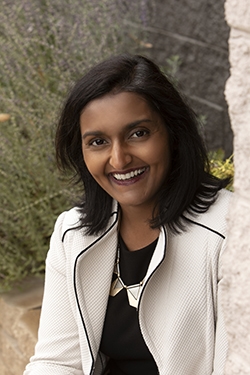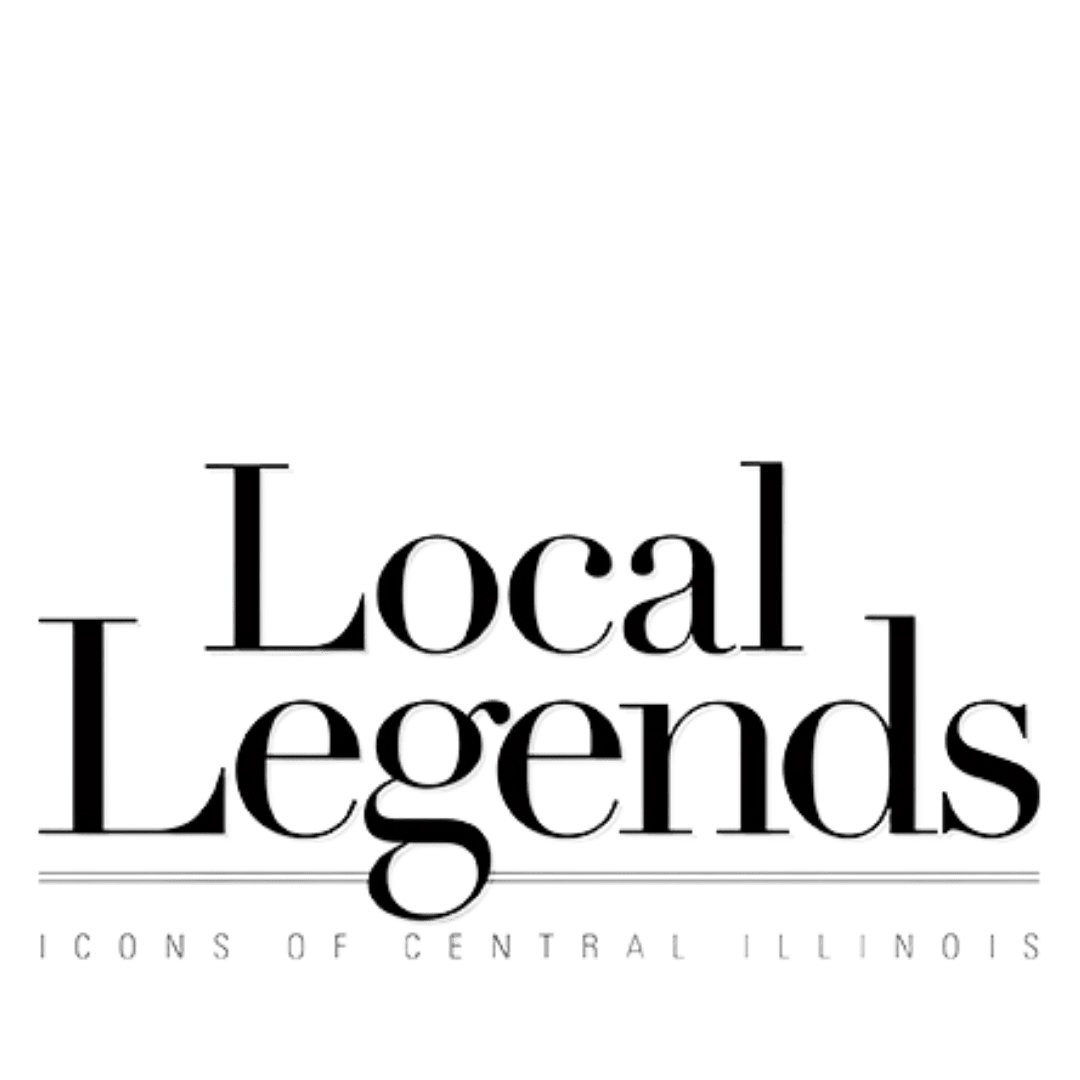As public health administrator in Peoria County, Monica Hendrickson, MPH puts her background in epidemiology to good use while overseeing programs and activities to protect the health of all residents. She works collaboratively with stakeholders across the Tri-County Area to create and implement strategies to improve population health and healthcare access, and has become a familiar face to Peorians as she guides the local response to the COVID-19 pandemic. In addition to coordinating health operations at Peoria’s Emergency Operations Center, she keeps the public well-informed through press briefings—fighting not only the virus, but widespread misinformation that places public health and safety at risk.
Tell us about your family and childhood, your hobbies, and your early influences.
The best way to describe me is as a daughter, a sister, a wife, an aunt and a mother. I’m the proud youngest child of hardworking immigrants. I have an older sister, who has been my north star for my entire life. I married my best friend in 2009 after meeting him in college. I get to spoil five nephews and nieces, and I’m the lucky mom of two precocious girls, who are nine and five.
While I was born just outside of Ann Arbor, Michigan, I’ve moved eight times within three states: Michigan, Georgia and Illinois. Moving taught me how to be adaptive and to put myself out there. I consider Illinois my home state, but my formative years were in Augusta, Georgia, which taught me everyone was “ma’am” and “sir.”
My hobbies include playing tennis, piano, hiking, rock climbing and traveling. In fact, my love for traveling, as well as many things in my life, was influenced greatly by my father.
My father has always inspired me because of his pioneering spirit, for not accepting the status quo, for valuing education and instilling in me the confidence to do anything and be anything. Every week he would take us to the public library and we would pore over the National Geographics. The yellow-edged magazine was filled with images throughout the world. We would look and plan ways to travel to these places and meet these people. My parents made sure my sister and I experienced a variety of cultures because it taught us just how similar we all are.
What inspired your interest in science, and more specifically, epidemiology and public health?
At an early age I enjoyed trying to figure how things worked; I once successfully took apart and put together our phone when I was little. I also loved how science and math are universal—that in all parts of the world, if you write an equation or chemical formula, it is the same.
I initially attended the University of Illinois at Urbana-Champaign, thinking I would pursue a career in medicine. However, during a family trip to India, I began to realize that I wanted to be able to address health issues before they started—that medicine, while a noble career, didn’t address the factors that significantly impacted health, such as housing, food security and poverty, and that providers could see hundreds of patients a day, but there were still more than seven billion people in the world. That is when I started looking towards public health, specifically epidemiology. I completed my master’s degree in public health at the University of Michigan, where I was introduced to population health epidemiology and public health policy. This provided me the ability to use statistics and data to analyze and prioritize what really impacted health, and in turn how to educate and develop policy to address it.
You have been a prominent figure communicating to the public during the COVID-19 pandemic. What have been some of your biggest challenges? What are you most proud of? 
There were two challenges I had in communicating during our COVID-19 response. The first was having to quickly recognize that those of us in public health were fighting two pandemics: the virus itself and misinformation. We cannot control all that is shared on social media, and this has created a constant distraction from the already monumental task of responding to a pandemic.
The second challenge, and most surprising for me, was how science was being held on trial in 2020—just as it was for Copernicus and Galileo nearly 500 years ago. I think some of the distrust in science comes from a need for instant validation, and again social media does well in finding like-minded individuals to fan these flames. Science by definition is a systematic approach: there is an idea or concept, followed by a hypothesis which is tested and either validated or rejected, and the cycle continues.
When science is not honestly implemented, people’s health and safety are put at risk. That is why I am most proud of our agency’s ability to address the misinformation by initially conducting daily press briefings. The public information officers at the health department, county and city coordinated communication, creating a platform to share information. We had local experts speak directly on the issues and what they meant for our community. This allowed our region to fully understand what was happening locally and provided a centralized source for the most up-to-date information.
As you and your colleagues have navigated the pandemic, are there any particular situations that stand out as especially meaningful?
It was the first week of March, and Peoria County and the City of Peoria decided to open our Emergency Operations Center. The EOC is a management system to effectively respond to various disasters, including a pandemic. I remember going over the list of entities that needed to be around the table, and started to make phone calls. Every person and agency we called not only readily answered our request, but did so in a way that allowed myself and public health to focus on the next step. I told my Director of Emergency Management and Preparedness that this was going to be a giant trust exercise, and our community partners rose to the occasion. Whether it was the Sheriff’s Office acting as a conduit for law enforcement, the Heart of Illinois United Way sharing information with social service providers, Home for All connecting with homeless shelters, the Regional Office of Education organizing food and remote education for students, the Greater Peoria EDC creating a business-focused site, or 2-1-1’s platform to answer COVID-19 questions, all of these groups and more were key in our response.
Describe your board service and community involvement. What causes are near and dear to you?
I believe it is important to be actively involved in the community where you live and serve. The ability to volunteer and support those efforts is key to creating a thriving community. The boards I’m currently on work to address equity issues in supporting an environment which seeks to have everyone achieve the highest outcomes, be it health, housing, income or education. I’m on the board and Solution Council of the Heart of Illinois United Way, where I am privileged to help fund agencies working directly on education, financial sustainability and health improvements. In addition, I recently joined the board of UnityPlace, which is supporting comprehensive mental health within our region. Likewise, Phoenix Community Development Services helps individuals gain self-sufficiency through supportive services, housing and homeless outreach. In Peoria, Tazewell and Woodford counties, the Partnership for a Healthy Community is a collaborative focused on assessing and addressing the health priorities in our region. And lastly, WTVP—because who doesn’t love Sesame Street?
What is your secret to maintaining a balance between your community work and personal life?
The secret is knowing two things. The first is that you will fail—that’s because the term balance indicates that you are at a constant equilibrium, but the truth is this equilibrium is not within a day, a week, a month or even a year. There are weeks where I miss breakfast and bedtimes and I can’t make it to practice. And then there are days when the computer stays off, the phone is silenced, and coloring pictures is the most important thing to do. What helps is knowing you can’t do it alone; it takes a team. For me, that includes my husband, my mother, my in-laws, friends and co-workers. The one thing I can always count on is that I never have to worry about the most important people in my life: my girls.
What advice would you give to a young, up-and-coming female professional?
The first advice I would give is: don’t be afraid to ask. Often times, I have peers who never asked, put themselves out there or took that opportunity. If you never put your hat into the ring, you never give yourself a chance to win. The worst that can happen is you hear “no.” But that is where the second piece of advice comes in: no doesn’t mean never. In fact, every time I received rejection, it has provided me with a chance to learn, work harder, get better and try again.
In your opinion, what is the greatest struggle working women face today?
While I understand the background of this question, my initial response is “having to answer questions like this.” To give context, I’m 38 years old—while there is still more work to do regarding equality for all, I would like to think we live in a time where the question is not specifically about working women but how to address the struggles of all individuals—and that includes examining equity.
Anything else you’d like to add?
This recognition is humbling for me. The work I get recognized for doing is not done in a silo but with a team of tremendous staff at the Peoria City/County Health Department. They have been working diligently to create a healthy and thriving community. I sincerely hope that people recognize the impact of public health in their lives. PM






